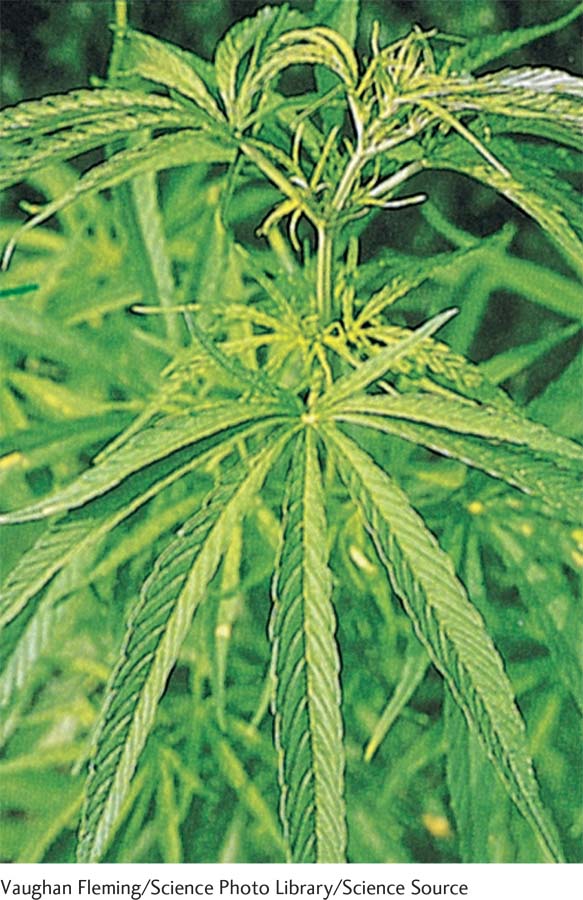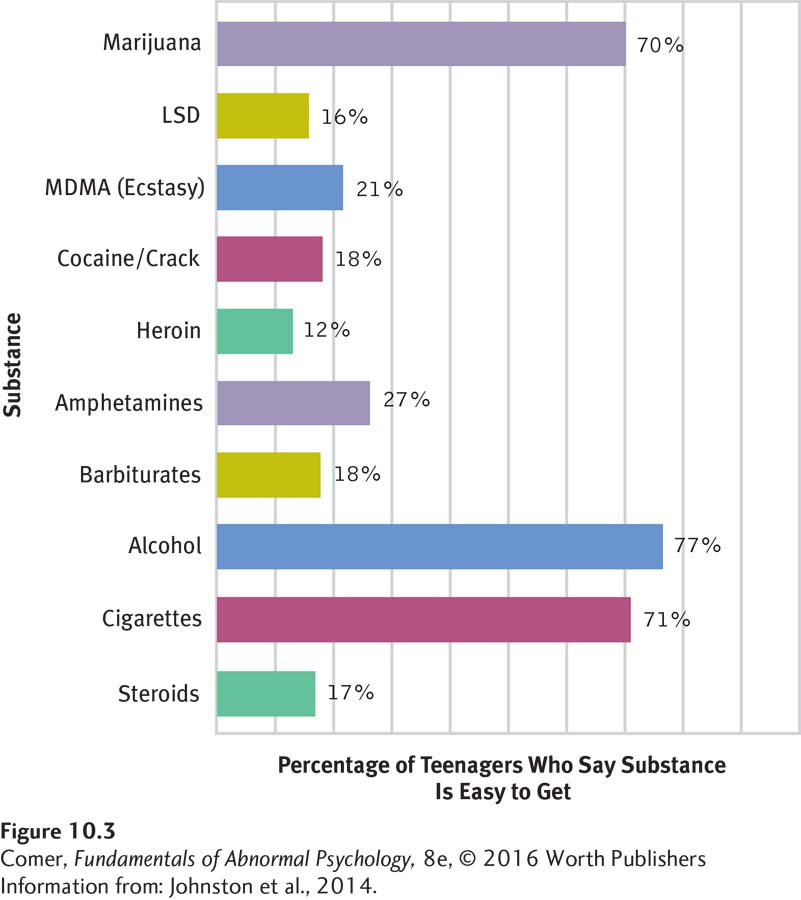10.3 Hallucinogens, Cannabis, and Combinations of Substances
Other kinds of substances may also cause problems for their users and for society. Hallucinogens produce delusions, hallucinations, and other sensory changes. Cannabis produces sensory changes, but it also has depressant and stimulant effects, and so it is considered apart from hallucinogens in DSM-
Hallucinogens
hallucinogen A substance that causes powerful changes primarily in sensory perception, including strengthening perceptions and producing illusions and hallucinations. Also called a psychedelic drug.
Hallucinogens are substances that cause powerful changes in sensory perception, from strengthening a person’s normal perceptions to inducing illusions and hallucinations. They produce sensations so out of the ordinary that they are sometimes called “trips.” The trips may be exciting or frightening, depending on how a person’s mind interacts with the drugs. Also called psychedelic drugs, the hallucinogens include LSD, mescaline, psilocybin, and MDMA (Ecstasy) (see PsychWatch on page 325). Many of these substances come from plants or animals; others are produced in laboratories.
LSD (lysergic acid diethylamide) A hallucinogenic drug derived from ergot alkaloids.
LSD (lysergic acid diethylamide), one of the most famous and most powerful hallucinogens, was derived by Swiss chemist Albert Hoffman in 1938 from a group of naturally occurring drugs called ergot alkaloids. During the 1960s, a decade of social rebellion and experimentation, millions of people turned to the drug as a way of expanding their experience. Within two hours of being swallowed, LSD brings on a state of hallucinogen intoxication, sometimes called hallucinosis, marked by a general strengthening of perceptions, particularly visual perceptions, along with psychological changes and physical symptoms. People may focus on small details—

Hallucinosis may also cause one to hear sounds more clearly, feel tingling or numbness in the limbs, or confuse the sensations of hot and cold. Some people have been badly burned after touching flames that felt cool to them under the influence of LSD. The drug may also cause different senses to cross, an effect called synesthesia. Colors, for example, may be “heard” or “felt.”
LSD can also induce strong emotions, from joy to anxiety or depression. The perception of time may slow dramatically. Long-
Why do various club drugs (for example, Ecstasy and crystal meth), often used at “raves,” fall in and out of favor rather quickly?
It seems that LSD produces these symptoms primarily by binding to some of the neurons that normally receive the neurotransmitter serotonin, changing the neurotransmitter’s activity at those sites (Advokat et al., 2014). These neurons ordinarily help the brain send visual information and control emotions (as you saw in Chapter 6); thus LSD’s activity there produces various visual and emotional symptoms.
More than 14 percent of all people in the United States have used LSD or another hallucinogen at some point in their lives. Around 0.4 percent, or 1.1 million people, are currently using them (NSDUH, 2013). Although people do not usually develop tolerance to LSD or have withdrawal symptoms when they stop taking it, the drug poses dangers for both one-
A 21-
(Frosch, Robbins, & Stern, 1965)

PsychWatch
Club Drugs: X Marks the (Wrong) Spot
You probably know of the drug MDMA (3,4-
What is Ecstasy’s allure? As a stimulant and hallucinogen, it helps to raise the mood of many partygoers and provides them with an energy boost that enables them to keep dancing and partying. It may also produce strong feelings of attachment and connectedness in users. However, it can be a dangerous drug, particularly when taken repeatedly.

What Are the Dangers of Using Ecstasy?
As MDMA has become more widely used, it has received more research scrutiny. As it turns out, the mood and energy lift produced by MDMA comes at a high price (Downey et al., 2015; Koczor et al., 2015; Hart & Ksir, 2014; Parrott et al., 2014). The problems that the drug may cause include the following:
Psychological problems such as confusion, depression, sleep difficulties, severe anxiety, and paranoid thinking.
Impairment of memory and other cognitive skills.
Physical symptoms such as muscle tension, nausea, blurred vision, faintness, and chills or sweating.
Increases in heart rate and blood pressure, which place people with heart disease at special risk.
Reduced sweat production. At a hot, crowded dance party, taking Ecstasy can even cause heat stroke, or hyperthermia. Users generally try to remedy this problem by drinking lots of water, but since the body cannot sweat under the drug’s influence, the excess fluid intake can result in an equally perilous condition known as hyponatremia, or “water intoxication.”
Potential liver damage.
How Does MDMA Operate in the Brain?
MDMA works by causing the neurotransmitters serotonin and (to a lesser extent) dopamine to be released all at once throughout the brain, at first increasing and then depleting a person’s overall supply of the neurotransmitters. MDMA also interferes with the body’s ability to produce new supplies of serotonin. With repeated use, the brain eventually produces less and less serotonin (Lizarraga et al., 2014; McDowell, 2011, 2005). Ecstasy’s impact on these neurotransmitters accounts for its various psychological effects and associated problems (Lizarraga et al., 2014; Zakzanis et al., 2007).
End of the Honeymoon?
Although it is no longer used as much as it was in the early 2000s, MDMA seems to have regained considerable popularity in recent years, finding its way back to raves, dance clubs, and various college settings (Johnston et al., 2014; Palamar & Kamboukos, 2014). Clearly, despite the alarming research results, the honeymoon for MDMA is not yet over.
Another danger is the long-
Cannabis

cannabis drugs Drugs produced from the varieties of the hemp plant Cannabis sativa. They cause a mixture of hallucinogenic, depressant, and stimulant effects.
marijuana One of the cannabis drugs, derived from the buds, leaves, and flowering tops of the hemp plant Cannabis sativa.
Cannabis sativa, the hemp plant, grows in warm climates throughout the world. The drugs produced from varieties of hemp are, as a group, called cannabis. The most powerful of them is hashish; the weaker ones include the best-
tetrahydrocannabinol (THC) The main active ingredient of cannabis substances.
Each of the cannabis drugs is found in various strengths because the potency of a cannabis drug is greatly affected by the climate in which the plant is grown, the way it was prepared, and the manner and duration of its storage. Of the several hundred active chemicals in cannabis, tetrahydrocannabinol (THC) appears to be the one most responsible for its effects. The higher the THC content, the more powerful the cannabis; hashish contains a large portion, while marijuana’s is small.
When smoked, cannabis produces a mixture of hallucinogenic, depressant, and stimulant effects. At low doses, the smoker typically has feelings of joy and relaxation and may become either quiet or talkative. Some smokers, however, become anxious, suspicious, or irritated, especially if they have been in a bad mood or are smoking in an upsetting environment. Many smokers report sharpened perceptions and fascination with the intensified sounds and sights around them. Time seems to slow down, and distances and sizes seem greater than they actually are. This overall “high” is technically called cannabis intoxication. Physical changes include reddening of the eyes, fast heartbeat, increases in blood pressure and appetite, dryness in the mouth, and dizziness. Some people become drowsy and may fall asleep.
In high doses, cannabis produces odd visual experiences, changes in body image, and hallucinations. Smokers may become confused or impulsive. Some worry that other people are trying to hurt them. Most of the effects of cannabis last two to six hours. The changes in mood, however, may continue longer.

Cannabis Use Disorder Until the early 1970s, the use of marijuana, the weak form of cannabis, rarely led to a pattern of cannabis use disorder. Today, however, many people, including large numbers of high school students, are developing the disorder, getting high on marijuana regularly and finding their social and occupational or academic lives very much affected (see Figure 10.3). Many regular users also develop a tolerance for marijuana and may feel restless and irritable and have flulike symptoms when they stop smoking (Chen et al., 2005). Around 1.7 percent of all teenagers and adults in the United States have displayed cannabis use disorder within the past month (SAMHSA, 2014; NSDUH, 2013).
Why have more and more marijuana users developed cannabis use disorder over the past three decades? Mainly because marijuana has changed. The marijuana widely available in the United States today is at least four times more powerful than that used in the early 1970s. The average THC content of today’s marijuana is 8 percent, compared with 2 percent in the late 1960s. Marijuana is now grown in places with a hot, dry climate, which increases the THC content.
Is Marijuana Dangerous? As the strength and use of marijuana have increased, researchers have discovered that smoking it may pose certain dangers (NIDA, 2015; Price, 2011). It occasionally causes panic reactions similar to the ones caused by hallucinogens, and some smokers may fear they are losing their minds (APA, 2000). Typically such reactions end in two to six hours, along with marijuana’s other effects.
Marijuana use can also adversely affect sensorimotor and cognitive functioning, especially among teenagers and children, whose brains are still developing (Barcott & Schererk, 2015). In turn, it has caused many automobile accidents (Brady & Li, 2014). Moreover, people on a marijuana high often fail to remember information, especially anything that has been recently learned, no matter how hard they try to concentrate; thus heavy marijuana smokers are at a serious disadvantage at school or work (Budney et al., 2011; Jaffe & Klein, 2010).

One study compared blood flow in the brain arteries of chronic marijuana users and nonusers (Herning et al., 2005). After one month of abstinence from smoking marijuana, chronic users continued to have higher blood flow than nonusers. Though still higher than normal, the blood flow of light marijuana users (fewer than 16 smokes per week) and of moderate users (fewer than 70 smokes per week) did improve somewhat over the course of the abstinence month. The blood flow of heavy users, however, showed no improvement. This lingering effect may help explain the memory and thinking problems of chronic heavy users of marijuana.
There are research indications that regular marijuana smoking may also lead to long-
Efforts to educate the public about the dangers of repeated marijuana use appeared to have paid off throughout the 1980s. The percentage of high school seniors who smoked marijuana on a daily basis decreased from 11 percent in 1978 to 2 percent in 1992. Today, however, 6.5 percent of high school seniors smoke it daily, and more than 50 percent of seniors do not believe that regular use poses a great risk (Johnston et al., 2014; NSDUH, 2013).
Cannabis and Society: A Rocky Relationship For centuries, cannabis played a respected role in medicine. It was recommended as a surgical anesthetic by Chinese physicians 2,000 years ago and was used in other lands to treat cholera, malaria, coughs, insomnia, and rheumatism. When cannabis entered the United States in the early twentieth century, mainly in the form of marijuana, it was likewise used for various medical purposes. Soon, however, more effective medicines replaced it, and the favorable view of cannabis began to change. Marijuana began to be used as a recreational drug, and its illegal distribution became a law enforcement problem. Authorities assumed it was highly dangerous and outlawed the “killer weed.”

In the 1980s, researchers developed precise techniques for measuring THC and for extracting pure THC from cannabis; they also developed laboratory forms of THC. These inventions opened the door to new medical applications for cannabis (Mack & Joy, 2001), such as its use in treating glaucoma, a severe eye disease. Cannabis was also found to help patients with chronic pain or asthma, to reduce the nausea and vomiting of cancer patients in chemotherapy, and to improve the appetites of people with AIDS and so help them combat weight loss.
In light of these findings, several interest groups began campaigning during the late 1980s for the medical legalization of marijuana, which operates on the brain and body more quickly than the THC capsules developed in the laboratory. Government agencies initially resisted this movement, saying prescriptions for pure THC served all needed medical functions. However, medical marijuana advocates pressed on, and in 2009 the U.S. Attorney General directed federal prosecutors to not pursue cases against medical marijuana users or their caregivers who are complying with state laws. Currently, 23 states have laws allowing marijuana to be used for medical purposes, and several more have such laws pending (Tilak, 2014).
Canada’s federal government has taken a more lenient position on the medical marijuana issue than the U.S. federal government. Based on a series of studies and trial programs, Health Canada, the country’s health care regulator, now legally permits people who are suffering from severe and debilitating illnesses to use marijuana for medical purposes. It allows the sale of medical marijuana in select pharmacies, and it licenses numerous companies to produce medical marijuana (Tilak, 2014).
Heartened by such developments in the realm of medical marijuana, a movement to legalize the recreational use of marijuana has gained enormous momentum in recent years. In fact, since 2012 residents in the states of Colorado, Washington, Alaska, and Oregon have voted to legalize marijuana for use of any kind. Moreover, according to recent polls, more than half of Americans believe that marijuana should be made legal, up from 12 percent in 1969 and 41 percent in 2010 (Pew Research Center, 2013).
Combinations of Substances
synergistic effect In pharmacology, an increase of effects that occurs when more than one substance is acting on the body at the same time.
Because people often take more than one drug at a time, a pattern called polysubstance use, researchers have studied the ways in which drugs interact with one another (Murray et al., 2015; De La Garza & Kalechstein, 2012). When different drugs are in the body at the same time, they may multiply, or potentiate, each other’s effects. The combined impact, called a synergistic effect, is often greater than the sum of the effects of each drug taken alone: a small dose of one drug mixed with a small dose of another can produce an enormous change in body chemistry.
One kind of synergistic effect occurs when two or more drugs have similar actions (McCance-
A different kind of synergistic effect results when drugs have opposite, or antagonistic, actions. Stimulant drugs, for example, interfere with the liver’s usual disposal of barbiturates and alcohol. Thus people who combine barbiturates or alcohol with cocaine or amphetamines may build up toxic, even lethal, levels of the depressant substances in their systems. Students who take amphetamines to help them study late into the night and then take barbiturates to help them fall asleep are unknowingly placing themselves in serious danger.

Each year tens of thousands of people are admitted to hospitals with a multiple-
Who has more impact on the drug behaviors of teenagers and young adults: rock performers who speak out against drugs or rock performers who praise drugs?
Fans mourn the deaths of many celebrities who have died from polysubstance use. For example, in 2014 the New York City medical examiner ruled that actor Philip Seymour Hoffman died of “acute mixed drug intoxication,” citing the presence of heroin, cocaine, benzodiazepines, and amphetamines in his system (Coleman, 2014). In the more distant past, Elvis Presley’s delicate balancing act of stimulants and depressants, Janis Joplin’s mixtures of wine and heroin, and John Belushi’s and Chris Farley’s liking for the combined effect of cocaine and opioids (“speedballs”) each ended in tragedy.
Summing Up
HALLUCINOGENS, CANNABIS, AND COMBINATIONS OF SUBSTANCES Hallucinogens, such as LSD, are substances that cause powerful changes primarily in sensory perception. People’s perceptions are intensified and they may have illusions and hallucinations. LSD apparently causes such effects by disturbing the release of the neurotransmitter serotonin.
The main ingredient of Cannabis sativa, a hemp plant, is tetrahydrocannabinol (THC). Marijuana, the most popular form of cannabis, is more powerful today than it was in years past. It can cause intoxication, and regular use can lead to cannabis use disorder.
Many people take more than one drug at a time, and the drugs interact. The use of two or more drugs at the same time—